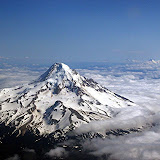Perspectives from a flight with a young child


Low level flight, and by low level I mean under 5,000 feet, is where the action is – at least in terms of appreciating what you can see in the natural world outside the cockpit. A recent low level flight through the Willamette valley supported this idea quite well. A still morning with visibility under a quarter of a mile and ceilings under 100 feet. I knew on the way to the airport it would be both a wait and that it would clear; the fog had that cheery bright glow which only seems to occur right before the sun breaks through, and indeed it DID breakthrough, bathing the freeway and cars in sunlight and shadow beneath a blue sky before popping back into the fog again.
Sure enough, it did clear after about a 30 minute wait at the airport. First movement was a landing Baron off the ILS. Next a fellow Cessna pilot warming up, and us, waiting to lift off in a venerable Cessna 152. At takeoff the sky was scattered and visibility was about 10 miles below the clouds and unlimited above. We climbed out at Vy for practice and settled into maneuvers routine. By then the sky was clearer and the natural wonders began appearing . On the way to Mulino , a local area airport, the sun glistened off the river and over the green fields wet from the recent rain and still radiating wisps’ of fog in some areas. A few touch and goes and we were heading back, when we saw two hawks fighting, at our altitude and about three plane widths away. Both were red-tails, and one was on his back, talons up and wings outstretched, with the hawk on top flapping towards him, claws facing down. Their muscles rippled beneath the feathers, you could see the waves of energy flowing through them in their exertion; you could also see their flight feathers, the long feathers at the tips of their wings – flexing and twisting as they maintained their balance through their duel. The tail feathers on the hawk on the bottom were widespread like a fan. They twisted, to counteract the body roll induced by a defensive movement made with its wings.
All of this could be seen in a split second as we went by. Remember, we were flying too, and climbing at about 80 knots. The hawks could only remain in our view angle from about the 11 o’clock opposition to the 8 o’clock position and they were very close to our aircraft so they went by in less than a second, yet the image was so powerful it will remain in my memory, perhaps for a life time.
Like the late night commercials say, “But wait! There’s more!” A few minutes later, practicing short and soft fields into Lenhart, another Willamette valley airport famed for its small size and tree lined approach and departure, I’d just completed a soft field landing on the grass and now, having taxied back, was on soft field and short field (combined!) take off roll, which demands considerable focus at Lenhart; the soft field really is soft, and the trees at the end of the runway really are there. My focus was all attitude and airspeed until reaching Vx, whereupon I relaxed pitch and trimmed for Vy. Upon stabilizing at Vy I looked out to enjoy the view and the conifer treetop to my left was bent over at the top, under the weight of a bald eagle. These are really large birds; there is no mistaking it. He turned and cocked his head slowly towards the plane and I could see his eye move. The bird did not flinch feather or twitch one muscle. He was aware of our presence and our presence did not matter to him. Then we were past yet still reveling in the moment. Just another moment flying, the most spectacular activity possible on the planet, certainly in the view of many pilots.
Onwards & Upwards!
Rob Bremmer











